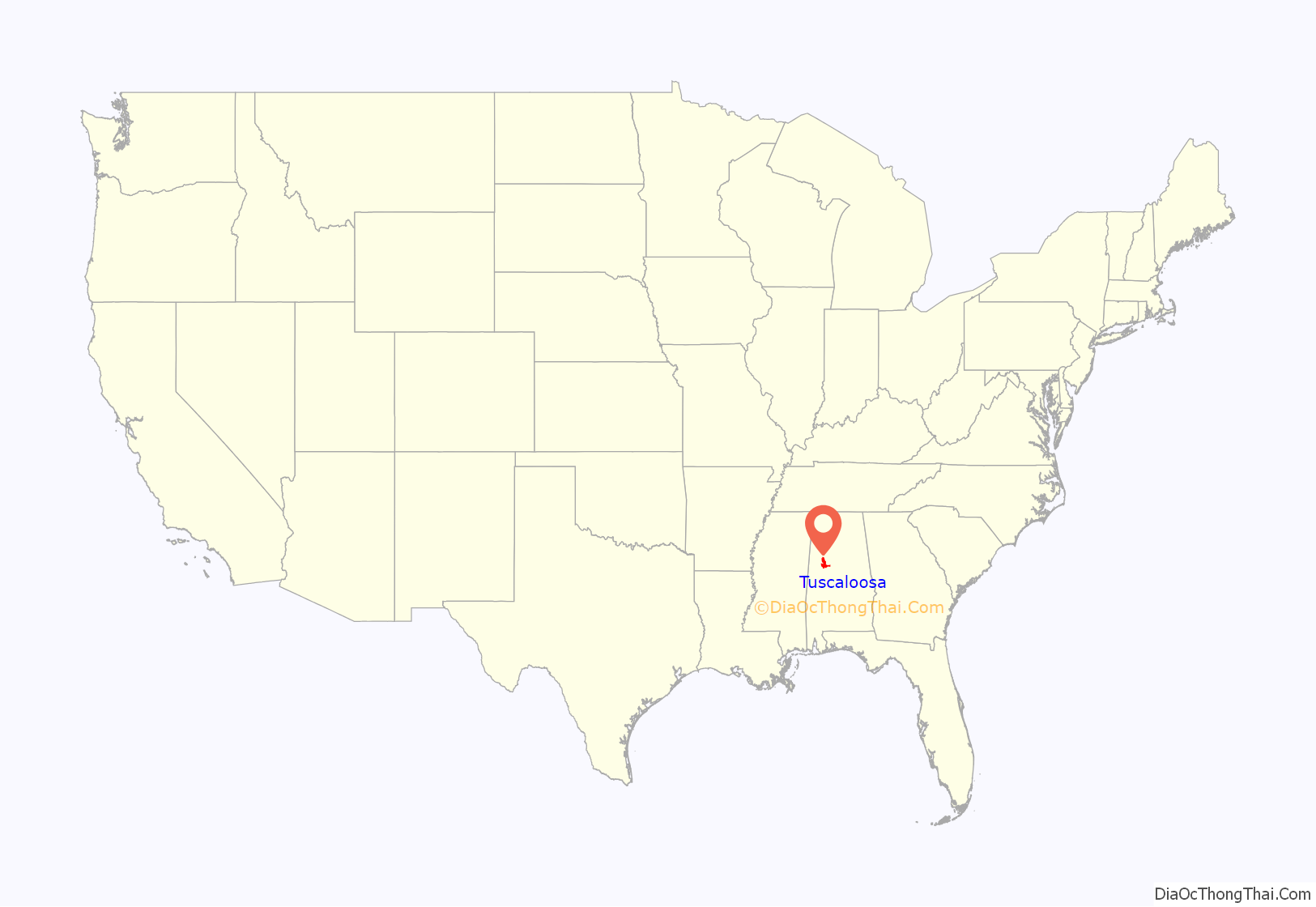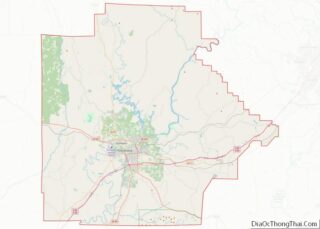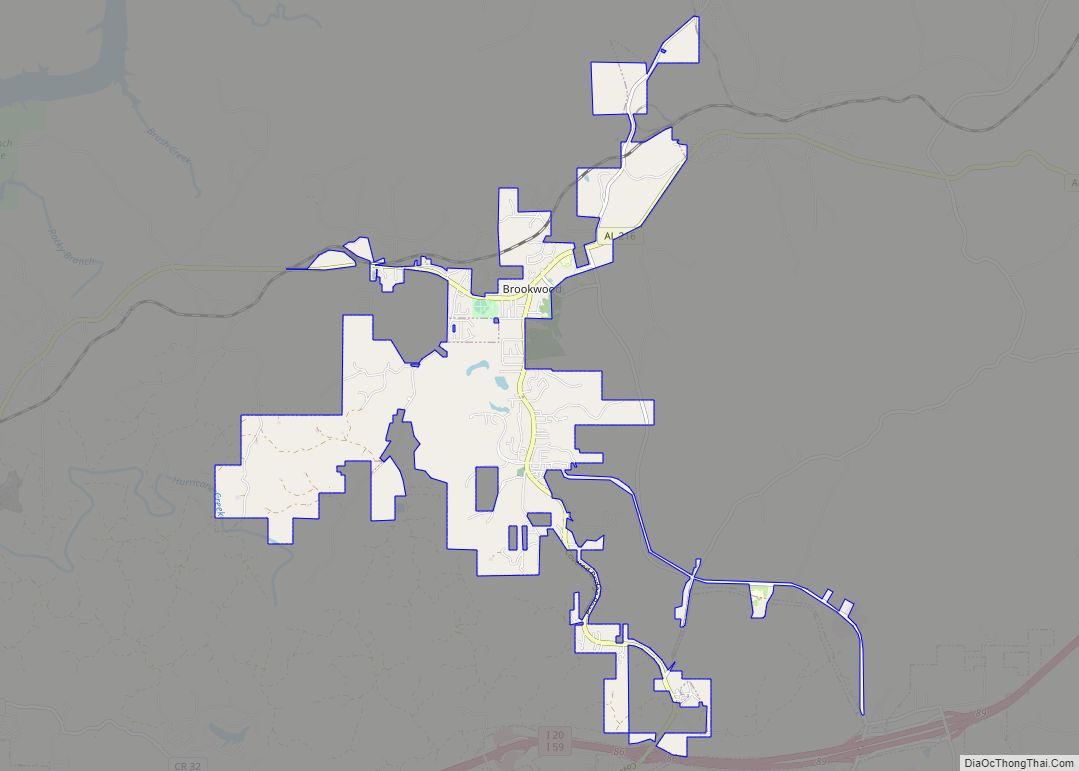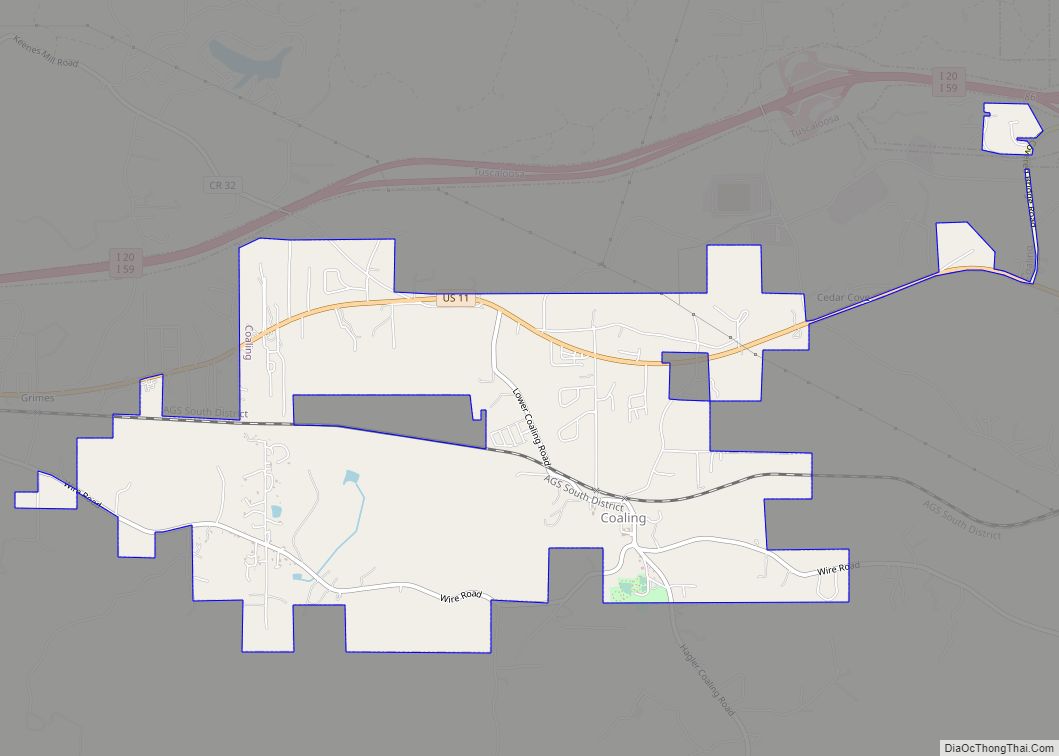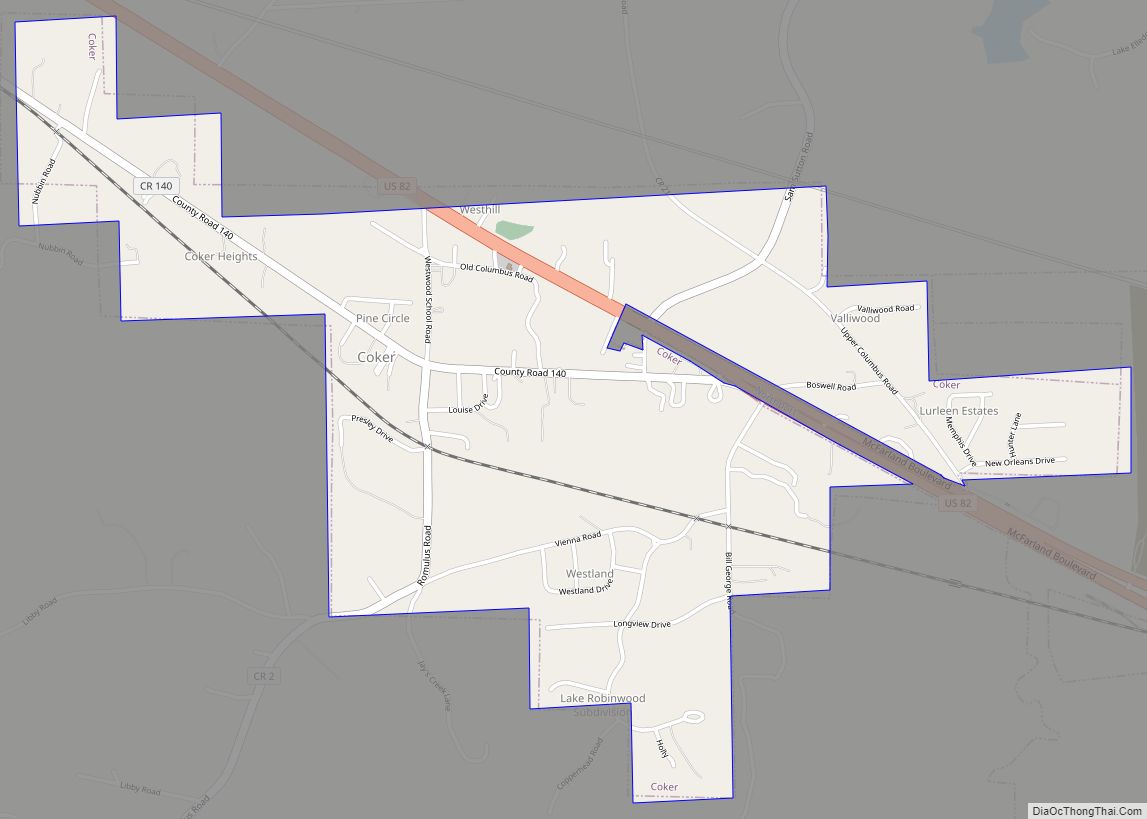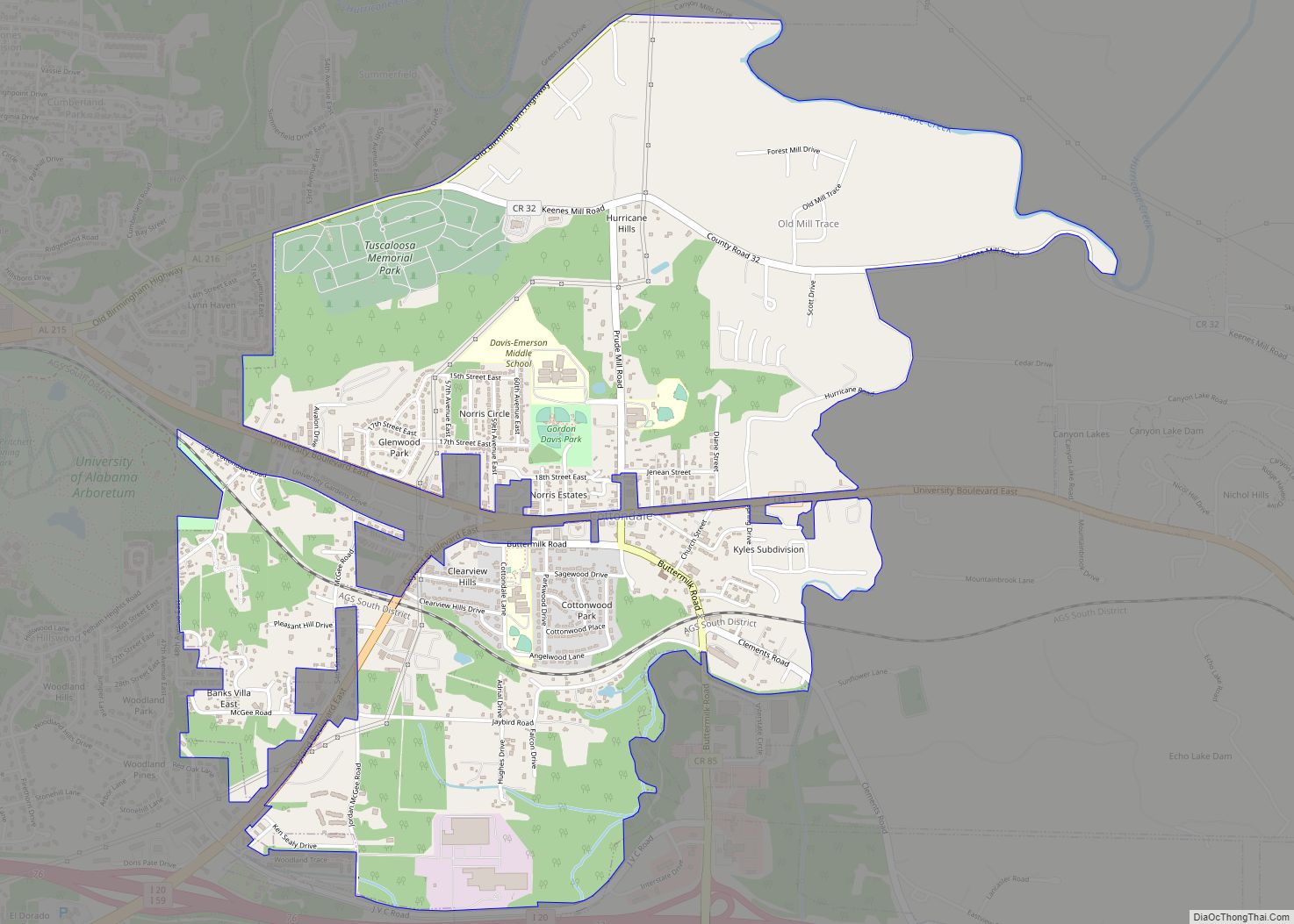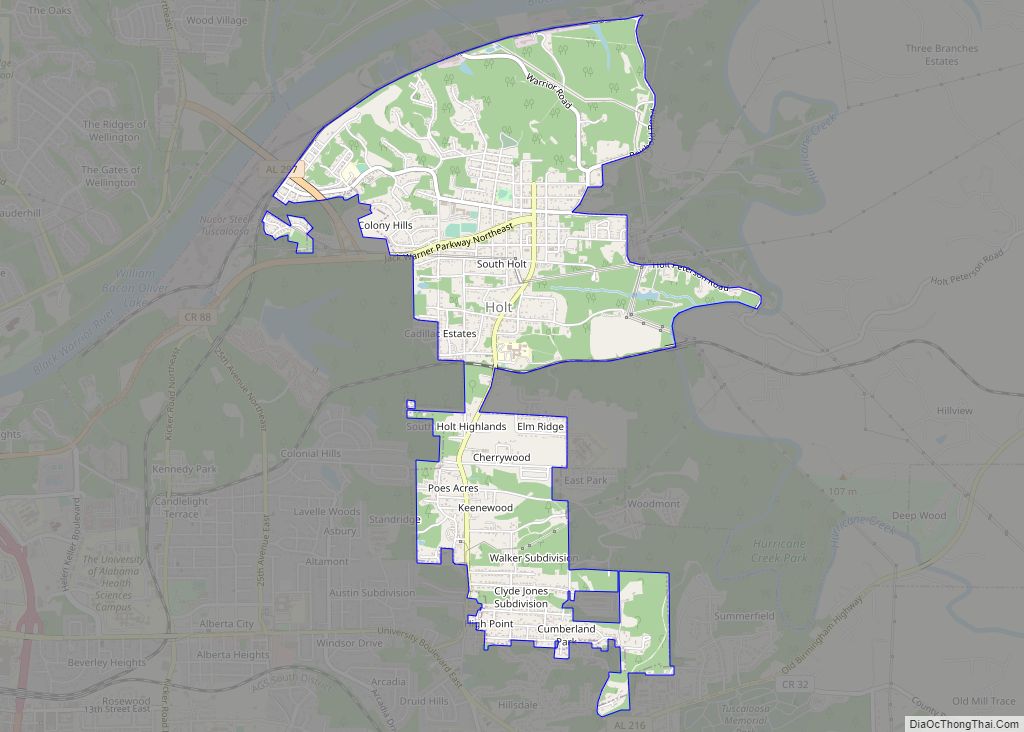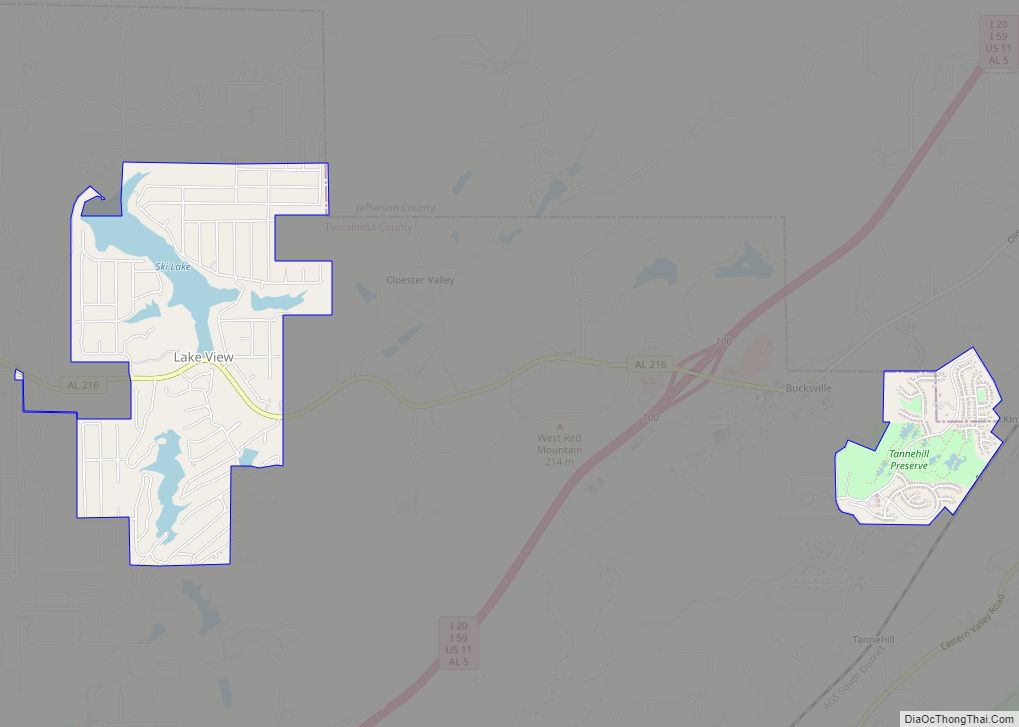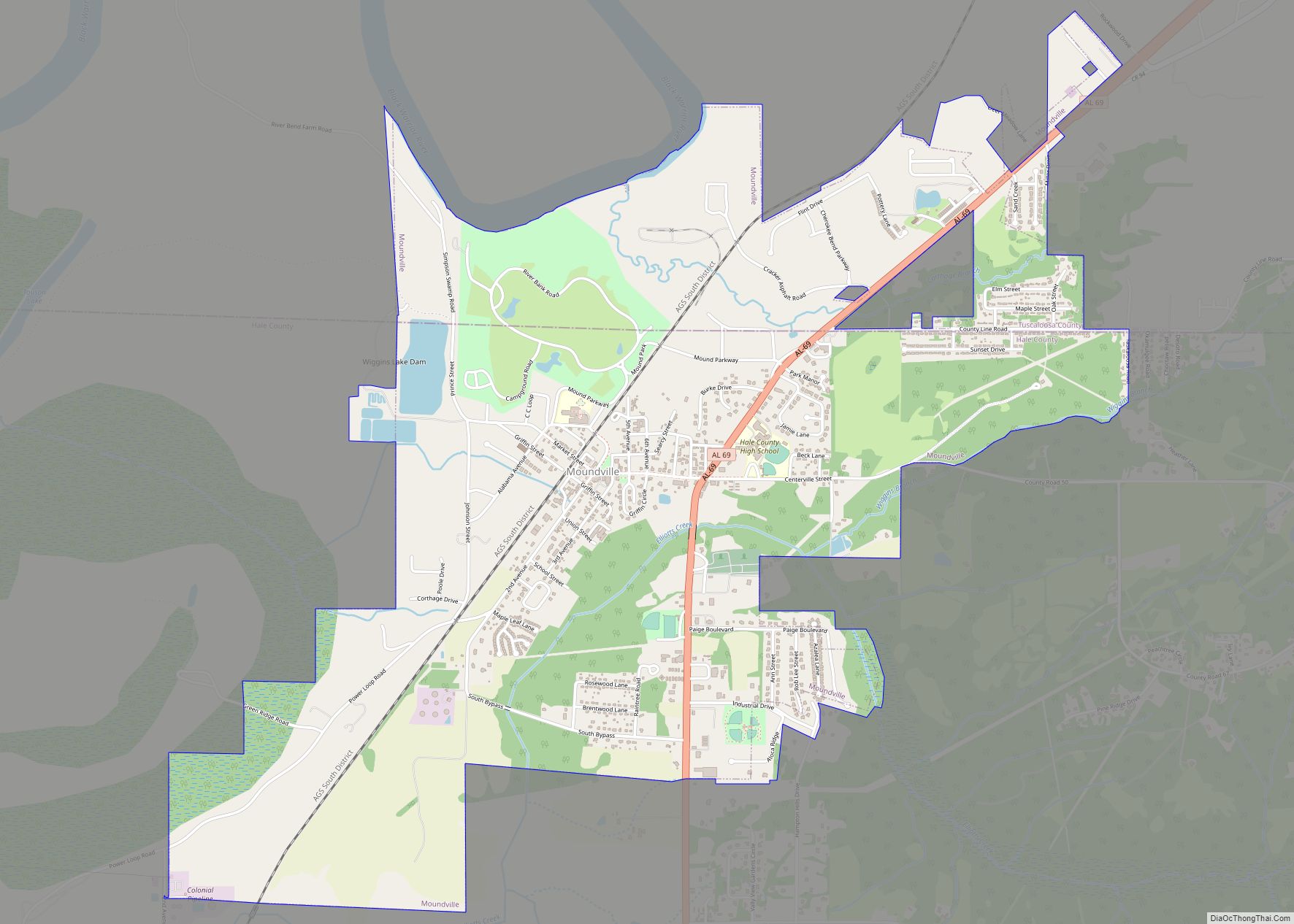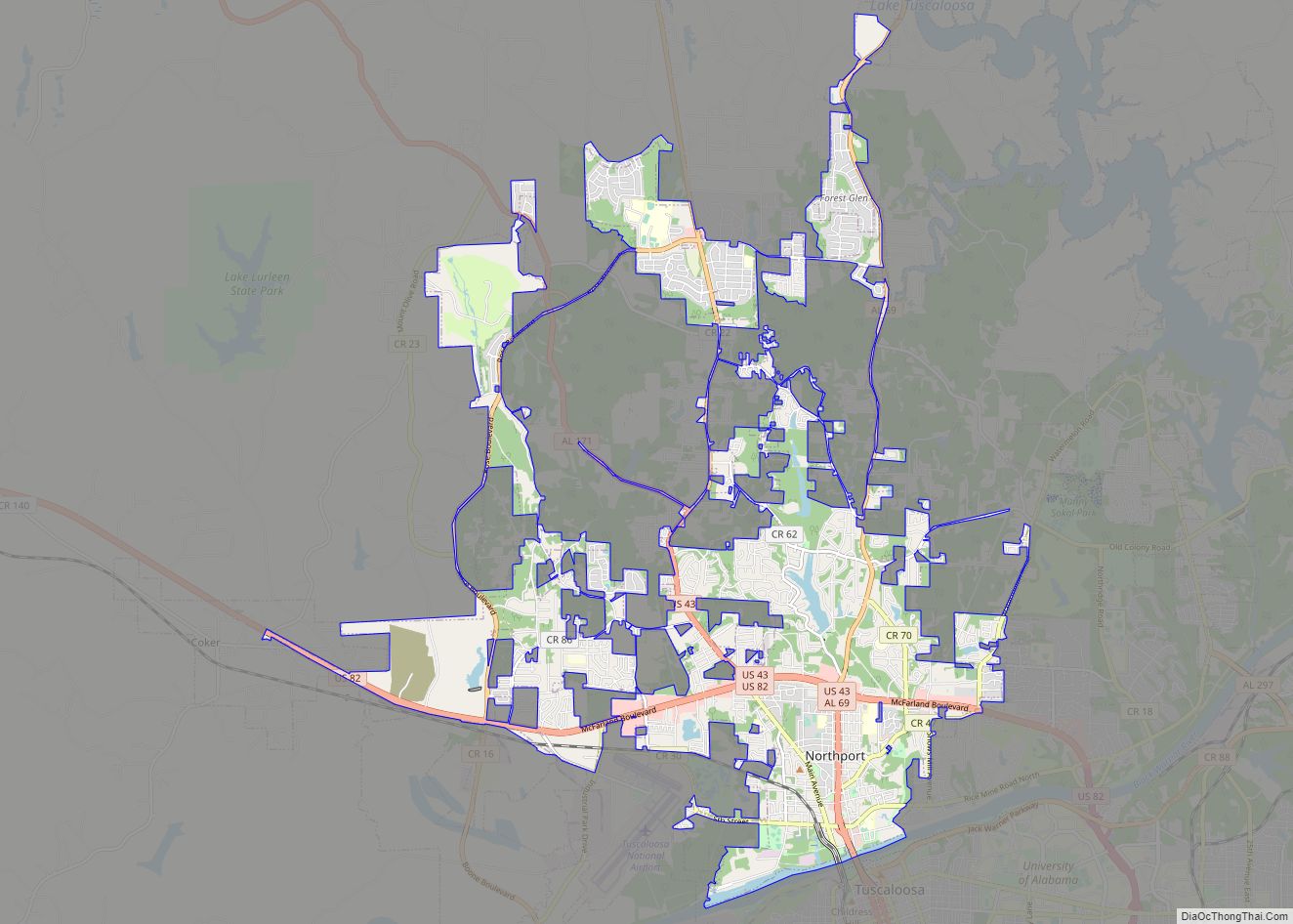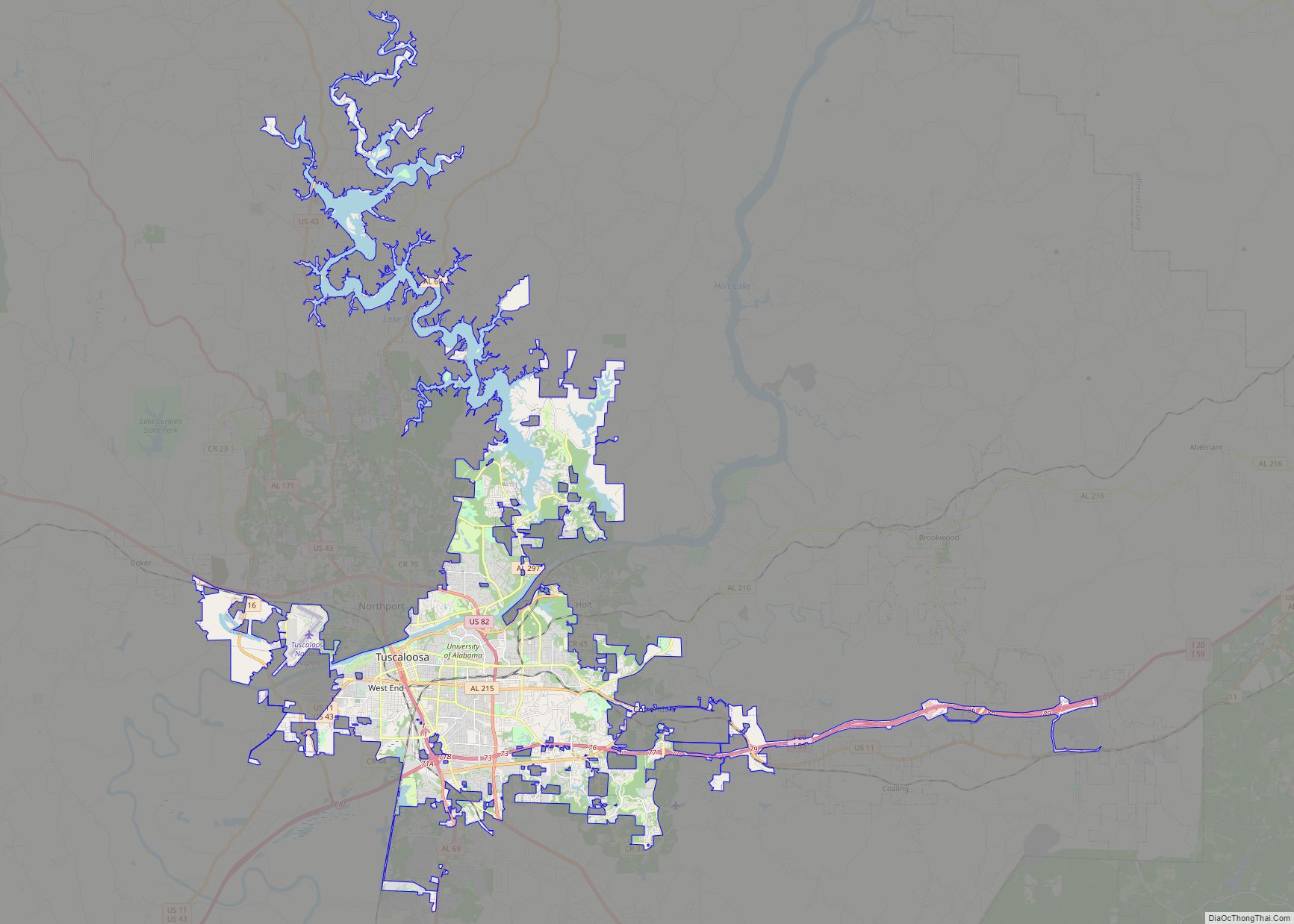Tuscaloosa (/ˌtʌskəˈluːsə/ TUS-kə-LOO-sə) is a city in and the seat of Tuscaloosa County in west-central Alabama, United States, on the Black Warrior River where the Gulf Coastal and Piedmont plains meet. Alabama’s fifth-largest city, it had an estimated population of 102,432 in 2022. It was known as Tuskaloosa until the early 20th century. It is also known as “the Druid City” because of the numerous water oaks planted in its downtown streets since the 1840s.
Incorporated on December 13, 1819, it was named after Tuskaloosa, the chief of a band of Muskogean-speaking people defeated by the forces of Spanish explorer Hernando de Soto in 1540 in the Battle of Mabila, in what is now central Alabama. It served as Alabama’s capital city from 1826 to 1846, where in 1846 it was moved to its present location in Montgomery.
Tuscaloosa is the regional center of industry, commerce, healthcare and education for the area of west-central Alabama known as West Alabama; and the principal city of the Tuscaloosa Metropolitan Statistical Area, which includes Tuscaloosa, Hale and Pickens counties.
It is the home of the University of Alabama, Stillman College and Shelton State Community College. While it attracted international attention when Mercedes-Benz announced on September 30, 1993 that it would build its first North American automotive assembly plant in Tuscaloosa County, the University of Alabama remains the city’s dominant economic and cultural engine, making it a college town. City leaders adopted the moniker “The City of Champions” after the Alabama Crimson Tide football team won the College Football National Championship in their 2009, 2011, 2012, 2015, 2017 and 2020 seasons.
In 2008, Tuscaloosa hosted the USA Olympic Triathlon trials for the Beijing Games.
| Name: | Tuscaloosa city |
|---|---|
| LSAD Code: | 25 |
| LSAD Description: | city (suffix) |
| State: | Alabama |
| County: | Tuscaloosa County |
| Incorporated: | December 13, 1819 |
| Elevation: | 222 ft (68 m) |
| Land Area: | 61.94 sq mi (160.43 km²) |
| Water Area: | 10.07 sq mi (26.09 km²) |
| Population Density: | 1,607.93/sq mi (620.83/km²) |
| ZIP code: | 35401-35407, 35485-35487 |
| Area code: | 205 & 659 |
| FIPS code: | 0177256 |
| GNISfeature ID: | 0153742 |
| Website: | www.tuscaloosa.com |
Online Interactive Map
Click on ![]() to view map in "full screen" mode.
to view map in "full screen" mode.
Tuscaloosa location map. Where is Tuscaloosa city?
History
Native American
In 1828, Andrew Jackson was elected president of the United States. He had gained popularity when he defeated the Creek at the Battle of Horseshoe Bend in 1814, following victories in the War of 1812. He long proposed Indian removal to an Indian Territory to be established west of the Mississippi, to make land available in the Southeast for European-American settlement. Jackson abandoned the policy of his predecessors of treating different Indian groups as separate nations. Instead, he aggressively pursued plans to move all Indian tribes living east of the Mississippi River.
Following Congressional passage of the Indian Removal Act, in 1832 the Creek National Council signed the Treaty of Cusseta, ceding their remaining lands east of the Mississippi to the U.S., and accepting relocation to the Indian Territory. They had already been under pressure from new settlers encroaching on their territory. Most Muscogee-speaking peoples were removed to Indian Territory during the Trail of Tears in 1834, although some remained behind. Some Muscogee in Alabama live near Poarch Creek Reservation in Atmore (northeast of Mobile).
Statehood and origin of name
The pace of white settlement in the Southeast increased greatly after the War of 1812 and the Treaty of Fort Jackson and the subsequent availability of land previously settled by Native Americans. A small assortment of log cabins soon arose near the large Creek village at the fall line of the river, which the new settlers named in honor of the sixteenth-century Chief Tuskaloosa of a Muskogean-speaking tribe—combining the Choctaw words “tushka” or “tashka” (“warrior”) and “lusa” (“black”).
In 1817, Alabama became a territory. On December 13, 1819, the territorial legislature incorporated the town of Tuskaloosa, one day before Congress admitted Alabama to the Union as a state.
From 1826 to 1846, Tuskaloosa was the capital of Alabama. The State House was built at the corner of 6th Street and 28th Avenue (now the site of Capitol Park). In 1831, the University of Alabama was established and the town’s population and economy grew rapidly, but the relocation of the capital to Montgomery caused a severe decline. The state legislature established Alabama State Hospital for the Insane (now Bryce Hospital) in Tuskaloosa in the 1850s, which helped restore the city’s fortunes.
Civil War
During the Civil War following Alabama’s secession from the Union, several thousand men from Tuscaloosa fought in the Confederate armies. During the last weeks of the War, the campus of the university was burned in a battle. The larger town was also damaged in the battle, and its White population suffered economically. Its Black population was emancipated from slavery.
In the 1890s the construction of a system of locks and dams on the Black Warrior River by the U.S. Army Corps of Engineers improved navigation to such an extent that Tuscaloosa was effectively connected to the Gulf Coast seaport of Mobile. This stimulated the economy and trade, and mining and metallurgical industries were developed in the region. By the onset of the 20th century, the growth of the University of Alabama and the mental health-care facilities in the city, along with a strong national economy, fueled a steady growth in Tuscaloosa which continued unabated for 100 years.
Civil rights movement
In the post World War II era, African Americans increased their activism to regain their constitutional civil rights, and challenged southern segregation in numerous ways. In 1952, Autherine Lucy was admitted to the university as a graduate student, but her admission was rescinded when authorities discovered she was not white. After three years of legal wrangling, Thurgood Marshall and the NAACP got a court order preventing the university from banning Lucy and another student based on race. The following year, Lucy enrolled as a graduate student in Library Science on February 3, 1956, becoming the first African American admitted to a white public school or university in the state. During her first day of class on February 6, students and others rioted on the campus, where a mob of more than a thousand white men pelted the car in which she was taken to her classes. Death threats were made against her and the university president’s home was stoned. The riots were the most violent involving a pro-segregation demonstration since the landmark Brown v. Board of Education Supreme Court decision. After the riots, the university suspended Lucy from school stating her own safety was a concern; it later expelled her on a technicality. She was active in civil rights for a time, but withdrew later that year. After her expulsion was annulled by the university in 1988, Lucy re-enrolled and completed her M.S. in education and graduated together with her daughter in 1992.
On June 11, 1963, George Wallace, governor of Alabama, stood in front of the Foster Auditorium entrance at The University of Alabama in what became known as the Stand in the Schoolhouse Door in an attempt to stop desegregation of that institution by the enrollment of two African-American students, Vivian Malone and James Hood. He had created a challenge to federal orders, when confronted by US Deputy Attorney General Nicholas Katzenbach and federal marshals sent in by Attorney General Robert F. Kennedy, Wallace stepped aside. President John F. Kennedy had supported integration of the University of Alabama as well.
On June 9, 1964, in an event that later became known as Bloody Tuesday, a group of peaceful African-American Civil rights marchers were beaten, arrested and tear gassed by police in Tuscaloosa while walking from the First African Baptist Church to the County Courthouse to protest against the segregated restrooms and drinking fountains of this public facility. Thirty-three people were sent to the hospital for treatment of injuries, and 94 were arrested. The events were not witnessed by outside journalists and had little influence outside the local community. A year later, the Bloody Sunday events in Selma of a voting rights march attracted national and international coverage and attention.
James Hood dropped out of the University of Alabama after two months. He later returned and, in 1997, received his Ph.D. in interdisciplinary studies. Malone persisted in her studies at the time and became the first African American to graduate from the university. In 2000, the university granted her an honorary doctorate of humane letters. Later in his life, Wallace apologized for his opposition at that time to racial integration.
In 2010, the university formally honored Lucy, Hood and Malone by renaming the plaza in front of Foster Auditorium as Malone-Hood Plaza and erecting the Autherine Lucy Clock Tower in the plaza.
2011 tornado
On April 27, 2011, Tuscaloosa was hit by a 1.5 mi (2.4 km) wide EF4 tornado that resulted in 64 deaths, more than 1500 injuries, and massive devastation. Most of the deaths, 44, were in Tuscaloosa alone, with the rest being in Birmingham and surrounding suburbs. The tornado’s top winds were estimated by the US National Weather Service at 190 mph (310 km/h). Officials at DCH Regional Medical alone reported treating more than 1,000 injured people in the tornado aftermath. Officials reported dozens of unaccompanied minors being admitted for treatment at the hospital, raising questions about the possible loss of their parents. Several were taken to pediatric trauma wards, indicating serious injuries. Referring to the extent and severity of the damage, Mayor Walter Maddox stated that “we have neighborhoods that have been basically removed from the map.” The same tornado later went on to cause major damage in the Birmingham area. In all, the cost of damage from the tornado amounted to $2.45 billion, making it, at the time, the costliest tornado in U.S. history, though it would be surpassed less than a month later by the devastating Joplin, Missouri tornado of May 22.
The tornado was part of the 2011 Super Outbreak which affected large parts of the eastern United States and was the largest tornado outbreak ever recorded. In total, 324 people were killed by tornadoes during the outbreak, including 238 in Alabama alone. The tornadoes and other severe weather combined for over $10 billion in damage throughout the affected states, with more than 20% of the damage cost resulting from the tornado that struck Tuscaloosa.
In the immediate aftermath of the tornado, thousands of rescue workers dug through the wreckage looking for survivors and recovering bodies. More than 450 persons were originally listed as missing in the post-disaster chaos, leading to fears that the death toll could climb rapidly and skepticism about the relatively low fatality figures in relation to the high number of casualties. Rumors abounded that refrigerated trucks were being brought to store unidentified remains, and that countless bodies were beneath area waters. But the fatality figure did not increase (and was later reduced). Most persons listed as missing were later found to have survived. During this period, The Tuscaloosa News posted an on-line people finder to aid people to find each other, as well as determine who was still missing.
Two days after the storm, US president Barack Obama and Alabama governor Robert Bentley, and their spouses, Michelle Obama and Diane Bentley, respectively, accompanied Mayor Maddox on a tour of the damage and the recovery efforts, along with FEMA Administrator Craig Fugate and several Congressional dignitaries. Remarking about the scale and severity of the damage, Obama said, “I’ve never seen devastation like this, it’s heartbreaking”, after touring the damaged areas. Obama pledged the full resources of the federal government toward aiding the recovery efforts. Bentley—himself a Tuscaloosa native—pledged additional national guard troops.
Tuscaloosa Mayor Walt Maddox announced that he was requesting 500 additional National Guard troops and calling for more volunteer aid workers and cadaver teams for the recovery of bodies, in order to prevent the spread of disease.
The New York Yankees organization contributed $500,000 to the American Red Cross and Salvation Army to aid in recovery efforts, and the Atlanta Braves organization donated $100,000. Actor Charlie Sheen visited the city to pay his respects on May 2 and donated supplies for relief efforts, along with several other actors, musicians and athletes.
Due to the disaster, on August 6, 2011, the University of Alabama held a delayed graduation ceremony for the class of 2011. It awarded posthumous degrees to six students who died in the tornado. The cable channel ESPN filmed a tribute in memory of the devastation.
Bicentennial
The city of Tuscaloosa celebrated its 200th birthday on December 13, 2019 with city officials holding various dedications and commemorative events throughout the city, including the displaying of a “bicentennial quilt” and a fireworks display following the 44th Annual West Alabama Christmas Parade, which was dedicated to the city’s birthday. The University of Alabama gifted two sculptures to the city, one of a 30 foot-tall, 9,500-pound statue of the Roman goddess Minerva—designed by local artist Caleb O’Connor—at Manderson Landing park along the Black Warrior River, and a sculpture known as The Walkway. According to the Tuscaloosa200.com website, the Walkway is a “replica of the route of the Black Warrior River from Demopolis to Tuscaloosa, it traces milestones in our city’s existence and survival, but its twists and turns, ebbs and flows have mirrored our city’s past.” It was created by sculptor and architect Craig R. Wedderspoon.
A hermetically-sealed time capsule was buried under a large boulder near the boat house near Manderson Landing; the time capsule is intended to capture “What was life like in Tuscaloosa during the year 2019?” and is set to be opened on December 13, 2069, the city’s 250th birthday.
Tuscaloosa Road Map
Tuscaloosa city Satellite Map
Geography
According to the U.S. Census Bureau, Tuscaloosa has a total area of 70.3 square miles (182 km), of which 60.2 square miles (156 km) is land and 10.1 square miles (26 km) is water. Most water within the city limits is in Lake Tuscaloosa, which is entirely in the city limits, and the Black Warrior River.
Tuscaloosa is located at 33°12′24″N 87°32′5″W / 33.20667°N 87.53472°W / 33.20667; -87.53472 (33.206540, −87.534607), approximately 60 miles (97 km) southwest of Birmingham. It lies on the fall line of the Black Warrior River, approximately 193 miles (311 km) upriver from the river’s confluence with the Tombigbee River at Demopolis. Because of its location on the boundary between the Appalachian Highland and the Gulf Coastal Plain, the geography of the area around Tuscaloosa is diverse, varying from heavily forested hills to the northeast to a low-lying, marshy plain to the southwest.
Cityscape
Major areas of Tuscaloosa city proper include:
- West Tuscaloosa
- Central/Midtown Tuscaloosa
- Downtown Tuscaloosa
- The University of Alabama main campus
- Alberta City
- North River
- Hillcrest
Climate
Typical of the Deep South, Tuscaloosa experiences a humid subtropical climate (Köppen Cfa). The Gulf of Mexico heavily influences the climate by supplying the region with warm, moist air. During the fall, winter, and spring seasons, the interaction of this warm, moist air with cooler, drier air from the North along fronts creates precipitation. These fronts usually move from west to east as they track along the jet stream. Notable exceptions occur during hurricane season, where storms may move from due south to due north or even from east to west during land-falling hurricanes. The interaction between low- and high-pressure air masses is most pronounced during the severe weather seasons in the spring and fall. During the summer, the jet stream flows well to the north of the southeastern U.S., and most precipitation is consequently convectional, i.e., caused by the warm surface heating the air above.
Severe thunderstorms can bring damaging winds, large hail, and occasionally tornadoes. An F4 tornado struck Tuscaloosa County in December 2000, killing eleven people. Tuscaloosa was struck by an F2 tornado in January 1997, which resulted in the death of one person. In April 2011, two tornadoes in a span of twelve days hit the city, the first being an EF3 on April 15, and the second and more devastating being an EF4 on April 27, when more than 50 deaths resulted. The city suffered considerable infrastructure damage.
Winter lasts from mid-December to late-February; the daily average temperature in January is 44.7 °F (7.1 °C). On average, the low temperature falls to the freezing mark or below on 46 days a year, and to or below 20 °F (−7 °C) on 4.4 days. While rain is abundant (January and February are on average the wettest months), measurable snowfall is rare, with most years receiving none and the average seasonal snowfall amounting to 0.7 inches (1.8 cm). Spring usually lasts from late-February to mid-May, becoming drier as the season progresses. Summers last from mid-May to mid-September, and the July daily average temperature is 81.7 °F (27.6 °C). There are 71–72 days of 90 °F (32 °C)+ highs annually and 3.5 days of 100 °F (38 °C)+ highs. The latter part of summer tends to be drier. Autumn, which spans from mid-September to early December, tends to be similar to spring in terms of temperature and precipitation.
The highest recorded temperature at the Tuscaloosa Regional Airport was 107 °F (42 °C) on July 29, 1952 and August 10, 2007, while the lowest recorded temperature was −1 °F (−18 °C) on January 21, 1985.
See also
Map of Alabama State and its subdivision:- Autauga
- Baldwin
- Barbour
- Bibb
- Blount
- Bullock
- Butler
- Calhoun
- Chambers
- Cherokee
- Chilton
- Choctaw
- Clarke
- Clay
- Cleburne
- Coffee
- Colbert
- Conecuh
- Coosa
- Covington
- Crenshaw
- Cullman
- Dale
- Dallas
- De Kalb
- Elmore
- Escambia
- Etowah
- Fayette
- Franklin
- Geneva
- Greene
- Hale
- Henry
- Houston
- Jackson
- Jefferson
- Lamar
- Lauderdale
- Lawrence
- Lee
- Limestone
- Lowndes
- Macon
- Madison
- Marengo
- Marion
- Marshall
- Mobile
- Monroe
- Montgomery
- Morgan
- Perry
- Pickens
- Pike
- Randolph
- Russell
- Saint Clair
- Shelby
- Sumter
- Talladega
- Tallapoosa
- Tuscaloosa
- Walker
- Washington
- Wilcox
- Winston
- Alabama
- Alaska
- Arizona
- Arkansas
- California
- Colorado
- Connecticut
- Delaware
- District of Columbia
- Florida
- Georgia
- Hawaii
- Idaho
- Illinois
- Indiana
- Iowa
- Kansas
- Kentucky
- Louisiana
- Maine
- Maryland
- Massachusetts
- Michigan
- Minnesota
- Mississippi
- Missouri
- Montana
- Nebraska
- Nevada
- New Hampshire
- New Jersey
- New Mexico
- New York
- North Carolina
- North Dakota
- Ohio
- Oklahoma
- Oregon
- Pennsylvania
- Rhode Island
- South Carolina
- South Dakota
- Tennessee
- Texas
- Utah
- Vermont
- Virginia
- Washington
- West Virginia
- Wisconsin
- Wyoming
